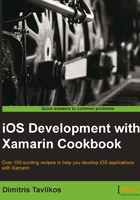
What this book covers
Chapter 1, Development Tools, teaches you how to install and use the development tools necessary to create your first iOS app. From there, you will create and debug your first Xamarin.iOS project.
Chapter 2, User Interface – Views, discusses the essential User Interface components of the iOS SDK. Covering the most commonly used views and controls and many more in detail, we will get familiar with the platform through a number of example projects. We will also discuss the similarities and differences with standard .NET components.
Chapter 3, User Interface – View Controllers, introduces you to the view controllers, the objects that are responsible for providing the interaction mechanism between your app and the user. Explained with simple step-by-step processes, you will start creating complete apps that can run on both the iPhone and iPad devices.
Chapter 4, Data Management, covers data management practices available on the iOS platform and how to use them efficiently with the convenience of C#. You will learn to manage locale SQLite database files, but also work on using iCloud to store data across different devices.
Chapter 5, Displaying Data, focuses on another important part of data management. Through a series of simple and complete projects, you will learn about the available components to display data on the screen of the iPhone, which are smaller than computer screens. Displaying various types of data in a user-friendly manner is essential for mobile devices, and by the time you finish reading this chapter, you will certainly be more skillful in this area.
Chapter 6, Web Services, guides you through .NET SOAP, WCF, and REST services for creating apps that connect the user to the world. These powerful .NET features would not have been part of iOS development without Xamarin.iOS.
Chapter 7, Multimedia Resources, will teach you to create applications that capture, reproduce, and manage multimedia content through the device's hardware. You will not only learn to use the camera to capture images and video, but also learn how to play back and record audio.
Chapter 8, Integrating iOS Features, will walk you through the ways to incorporate the platform's native applications and components. You will learn how to provide e-mail, text messaging, and address book features in your application and how to use the native calendar to create events.
Chapter 9, Interacting with Device Hardware, discusses creating applications that are fully aware of their surrounding environment through the device's sensors. You will learn to adjust the User Interface according to device orientations and respond to accelerometer and gyroscope events.
Chapter 10, Location Services and Maps, is a detailed guide for using the built-in location services to create applications that provide location information to the user. You will not only learn to use the GPS hardware, but also how to display and layout information on maps.
Chapter 11, Graphics and Animation, introduces 2D graphics and animation. You will learn to animate components and draw simple graphics on the screen. By the end of this chapter, you will create a small finger-drawing application.
Chapter 12, Multitasking, will walk you through the details of implementing multitasking in iOS applications. This dramatically enhances the user experience by executing code behind the scenes.
Chapter 13, Localization, discusses how to provide localized content in applications. You will learn how to prepare your application to target users worldwide.
Chapter 14, Deploying, will not only walk you through the required steps to deploy your finished application to devices, but also to prepare and distribute it to the App Store.
Chapter 15, Advanced Features, introduces some of the key features introduced in newer iOS versions, such as implementing physics to User Interface components through the power of iOS 7's UIKit Dynamics, customizing animated transitions between view controllers, and more!